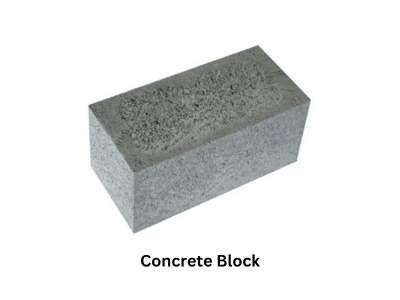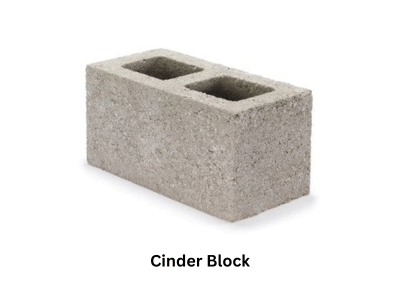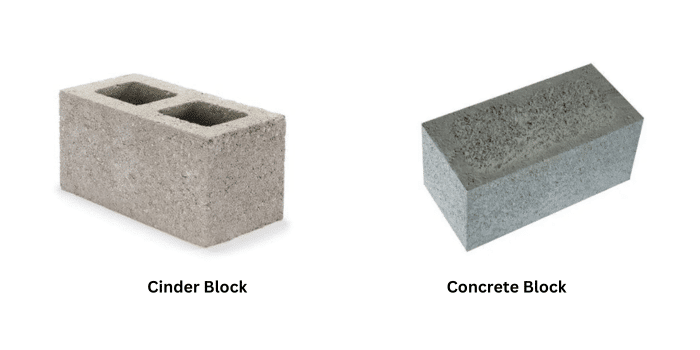Table of Contents
Cinder Block Vs Concrete Block
The general public frequently confuses the phrase “cinder block” with “concrete block.”
Despite the fact that they have certain fundamental similarities, there are a lot of distinctions between them.
People frequently make the mistake of supposing them to be the same thing. The differences between cinder blocks and concrete blocks will be discussed in this post.
Read the whole article to get an in-depth understanding of the many ways in which concrete blocks and cinder blocks differ.
What is Concrete Block?
Air, water, cement, and small rocks called “aggregates” make up concrete blocks. When these things are mixed together, they cause a chemical process that makes concrete.
Finely crushed stones or sand, like cement, are the only things that can be used as filler in concrete blocks.

A rectangular block composed of concrete and aggregate elements is often known as a cinder block or concrete masonry unit (CMU).
Aggregates like crushed stone or gravel, sand portland cement, and water are typically used to create concrete blocks.
Concrete blocks are more long-lasting than the traditional cinder blocks formed from burned resources like coal and limestone.
These blocks can be utilized for many various kinds of buildings. Their durability and flexibility make them an excellent choice for a wide variety of masonry projects. Concrete block construction is ideal for interior walls and floors.
Concrete blocks add an extra measure of protection and security to a building because of their resistance to fire.
Moreover, you can mold concrete blocks into almost any form you can imagine. When building walls or other masonry structures, this allows for a wide range of aesthetic possibilities.
Concrete blocks come in a wide range of sizes, forms, and strengths, and are manufactured in large quantities at factories. Concrete blocks are widely used because they are cheap, plentiful, and versatile.
What is Cinder Block?
A cinder block is a construction material often composed of concrete, sand, and gypsum. It is commonly used for constructing walls, patios, and other masonry structures.
When compared to other masonry materials like bricks and mortar or poured concrete, cinder blocks are much lighter and more manageable.
Portland cement, water, sand, and coal fly ash, sometimes known as cinders, are the four basic components of cinder blocks.
The cinders serve as the glue that binds everything else together, and they also provide the final product with a substantial boost in strength and longevity.
Portland cement acts as a glue that holds everything together while also giving it a solid foundation.
The Portland cement in the cinder block forms a strong binding with the other ingredients thanks to the addition of water.

Sand is added at the end to fill up any remaining spaces, making for a denser block that can withstand more pressure and weight when used in the building.
Depending on the use, cinder blocks might be anywhere from 4 inches by 8 inches by 16 inches to 12 inches by 24 inches by 32 inches. Construction projects call for cinder blocks of varying colors, textures, shapes, and sizes.
They feature a wide variety of faces that can be divided and carved into various forms. They have the strength of conventional masonry materials without the hefty price tag.
One important thing sets cinder blocks apart from concrete blocks. Concrete blocks can only use carefully crushed stones as the aggregate, but cinder blocks can use many different things, with cinder being the most common.
Cinder, made from burned wood or coal, can be used instead of stones in concrete blocks to make them lighter and lower the cost of making them.
Cinder blocks are an environmentally preferable option because they may be manufactured from coal or wood waste.
Difference Between Cinder Block And Concrete Block

| S. No. | Cinder Block | Concrete Block |
|---|---|---|
| 1 | Fly ash is used as the filler in cinder blocks. | Ash is used to make wall units in concrete blocks |
| 2 | cinder blocks have the shape of a hollow square. | A concrete block has a shape that is flattened. |
| 3 | Cinder blocks are made from coal cinders and concrete. | Concrete blocks are made using cement, steel, and wood. |
| 4 | Cinder blocks weigh less than cement blocks. | Stone or sand is mixed into a concrete block, which makes it heavy. |
| 5 | Cinder blocks can easily crack under intense stress. | Concrete block is hard and lasts a long time. |
| 6 | Cinder blocks aren’t very strong, so many building rules say you can’t use them. | A concrete block is a sturdy and durable building material. |
| 7 | Cinder blocks are used in small places like landscapes, yards, or building walls. | Concrete blocks are typically utilized for larger, more significant building projects. |
| 8 | Cinder blocks look old because they haven’t been made in large quantities in 50 years. | Concrete blocks are in high demand because they are strong and have more benefits than wooden blocks. |
| 9 | Cinder Block costs extra because it requires greater maintenance. | It’s easy to pay for concrete blocks. |
| 10 | Cinder block is often forbidden due to its inflexibility. | Because of their superior strength, concrete blocks can be utilized in virtually any construction. |
Also, Read
What is CMU Wall? CMU Wall Construction|CMU Block|Cinder Block
18 Most Popular Types of Wood And Their Uses
What is Skirting? – Purpose & Types|Types of Skirting In Construction
Cost-Effective Ways to Enhance The Durability of Your Wood Floor